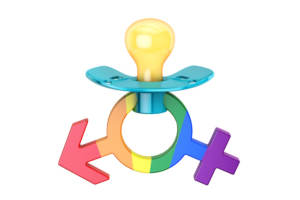LGBTQ Families: Breaking Boundaries And Sharing Love

Some definitions of the nuclear family emerge from religious and politically conservative ideologies. Nevertheless, LGBTQ individuals have created families on their own terms for a long time. A recent story from Oregon in which one couple broke gender boundaries illustrates this point perfectly. While a man giving birth might seem newsworthy and even shocking to some, it’s just one example of how family can be formed in a variety of ways.
The Story of Trystan Reese and Biff Chaplow
In an August 2017 article, CNN featured a same-sex couple in Portland who recently welcomed their newest addition, a baby boy named Leo. The two men, Trystan Reese and Biff Chaplow, had been together for seven years and had adopted Chaplow’s nephew and niece earlier in the relationship. Unlike many same-gender couples who opt to have a child, they did not require the help of a donor or surrogate. Instead, Reese carried their son to term and gave birth to him on July 14.
When CBS News profiled the happy couple on August 4, it reported that Reese, a transgender man, had started taking testosterone at age 20 but had not undergone invasive gender-confirming procedures. As Huffington Post contributor Mitch Kellaway clarified in a March 2014 essay, it’s common for transgender men to forgo “bottom surgery” for financial, practical or other reasons. In Reese’s case, that meant he could conceive and bear children after suspending hormone treatments.
During his pregnancy, Reese remained under medical supervision to ensure that both he and their baby were healthy. As PinkNews also reported in early August, he welcomed the possibility of being able to have a biological child with his partner. “For me, I see it as a really amazing gift that I’ve been given,” he stated. “I get to live as a man, and I also get to do this really amazing thing that a lot of people would love to do.”
Other Trans Men Opt to Bring Life Into Their LGBTQ Families
Reese is not the first transgender man to carry a child to term. The earliest recorded instance in the United States occurred when Matt Rice gave birth to a son in 1999. PinkNews also disclosed that within the last two years, 54 trans men in Australia alone have done the same thing. As contributor Meka Beresford explained, the recent increase might be attributed to new record keeping practices by its health administration. Starting in 2013, the agency began keeping track of gender identities, which allowed transgender Aussies to access needed reproductive and other health services.
The Challenges of Being a Pregnant Man
Whether a trans man can safely handle bearing children depends on his need for gender-affirming therapies, his overall health and other individual factors. Monthly menstruation and the prospect of pregnancy can trigger gender dysphoria, a state of distress resulting from an incongruence between his assigned gender at birth and his actual gender. Additionally, he may encounter other challenges when choosing to gestate his own children. A 2014 NPR piece mentioned a study conducted by the American College of Obstetricians and Gynecologists in which pregnant trans men reported difficulty accessing necessary medical care. Common problems indicated by respondents included confusion and hostility from healthcare practitioners, misgendering by medical staff, and even denial of vital prenatal services.
With Love and Support, Expanded Possibilities
Both Chaplow and Reese are now enjoying life at home with their young son. “There are so many different configurations of families, all of which are valid and full of love and respect and integrity,” Reese told CBS News. His words ring true for many LGBTQ families as they create spaces of love and support while making their way in the world.














